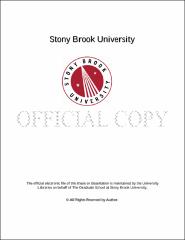| dc.identifier.uri | http://hdl.handle.net/11401/76541 | |
| dc.description.sponsorship | This work is sponsored by the Stony Brook University Graduate School in compliance with the requirements for completion of degree. | en_US |
| dc.format | Monograph | |
| dc.format.medium | Electronic Resource | en_US |
| dc.language.iso | en_US | |
| dc.publisher | The Graduate School, Stony Brook University: Stony Brook, NY. | |
| dc.type | Dissertation | |
| dcterms.abstract | This dissertation examines the mechanism of transfer of <italic>B. burgdorferi</italic>-derived antigenic lipids to non-phagocytic eukaryotic cells and how the mechanism of transfer of foreign antigenic bacterial lipids could contribute to the pathogenesis of Lyme disease. Lipid rafts are structural subdomains of the plasma membrane that are primarily found in eukaryotic cells due to the presence of cholesterol and glycosphingolipids. Interestingly, the presence of these membrane subdomains is also shared with the spirochetal prokaryote B. burgdorferi. The presence of free cholesterol and cholesterol-glycolipids in B. burgdorferi creates an opportunity for lipid-lipid interactions with constituents of the lipid rafts in eukaryotic cells. To investigate possible lipid-lipid interactions between <italic>B. burgdorferi</italic> and eukaryotic cells, fluorescent cholesterol analogs were utilized to label not only the entire membrane of these cells, but also the individual cholesterol-glycolipids of the spirochetes. Using transfer assays that examined the cells in a population and at the single-cell level, it was observed that there is a two-way exchange of lipids between <italic>B. burgdorferi</italic> and epithelial cells. In investigating these transfer events, free cholesterol and the antigenic cholesterol-glycolipids of <italic>B. burgdorferi</italic> were transferred to epithelial cells through direct contact and/or through outer membrane vesicles. Using the same fluorescent cholesterol analog, cholesterol was also shown to be acquired by the bacteria from the plasma membrane of the epithelial cells. Given the limited biosynthetic capabilities of <italic>B. burgdorferi</italic>, acquisition of available cholesterol from the host appears to be essential for the spirochetes' growth. The two-way transfer of lipids could play a critical role in the pathogenesis of spirochetoses. One manifestation that the transfer event could contribute to is the generation of antibodies that cross-react with both bacterial and host molecules. In addition, the transfer of the antigenic glycolipids to the host cells could be a mechanism whereby the inflammatory and immune response of the host could recognize cells bearing spirochetal antigens, leading to the development of neurological and joint manifestations of Lyme disease. | |
| dcterms.available | 2017-09-20T16:50:36Z | |
| dcterms.contributor | Furie, Martha | en_US |
| dcterms.contributor | Benach, Jorge L | en_US |
| dcterms.contributor | Fleit, Howard | en_US |
| dcterms.contributor | Thanassi, David G | en_US |
| dcterms.contributor | London, Erwin. | en_US |
| dcterms.creator | Crowley, Jameson Thatcher | |
| dcterms.dateAccepted | 2017-09-20T16:50:36Z | |
| dcterms.dateSubmitted | 2017-09-20T16:50:36Z | |
| dcterms.description | Department of Molecular Genetics and Microbiology. | en_US |
| dcterms.extent | 205 pg. | en_US |
| dcterms.format | Monograph | |
| dcterms.format | Application/PDF | en_US |
| dcterms.identifier | http://hdl.handle.net/11401/76541 | |
| dcterms.issued | 2013-12-01 | |
| dcterms.language | en_US | |
| dcterms.provenance | Made available in DSpace on 2017-09-20T16:50:36Z (GMT). No. of bitstreams: 1
Crowley_grad.sunysb_0771E_11476.pdf: 5918892 bytes, checksum: 9c9beb94c791ce8e481c8966808dc066 (MD5)
Previous issue date: 1 | en |
| dcterms.publisher | The Graduate School, Stony Brook University: Stony Brook, NY. | |
| dcterms.subject | Biology | |
| dcterms.subject | Borrelia burgdorferi, cholesterol, lipid exchange, lipid rafts, Lyme disease | |
| dcterms.title | Lipid Exchange between Borrelia burgdorferi and host cells | |
| dcterms.type | Dissertation | |

